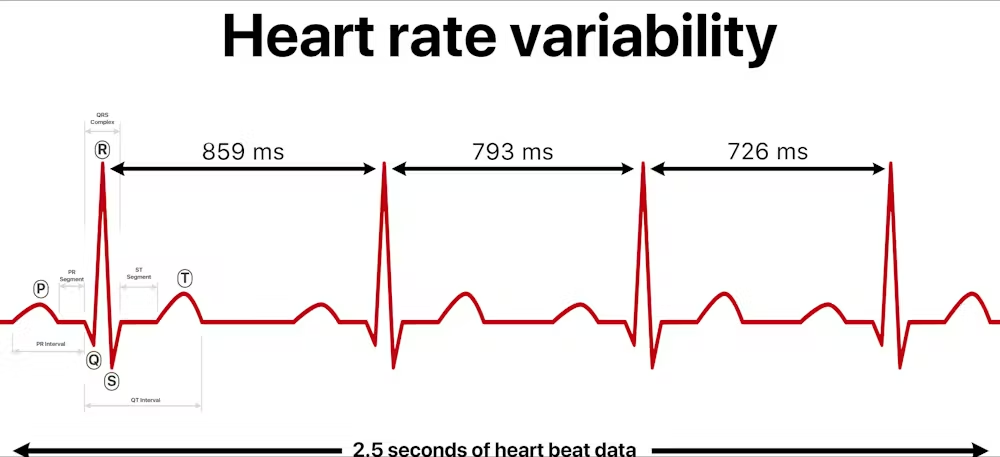12 de August de 2025
Understand the HRV Data to Optimize Your Recovery
In high-performance training, recovery is not a fixed interval — it’s a dynamic physiological state. And one of the most powerful windows into that state is HRV data. Heart rate variability (HRV) is no longer a vague wellness metric reserved for endurance athletes or biohackers. For strength and conditioning (S&C) coaches, HRV offers real-time insights into how an athlete is responding to training stress, sleep, psychological load, and overall recovery demands.
But to leverage HRV effectively, you need to understand what the data actually means, how it behaves across different training cycles, and how to integrate it with your performance programming. Let’s break it down.
What Is Heart Rate Variability (HRV) and Why Does It Matter?
Heart rate variability refers to the variation in time between consecutive heartbeats. Unlike resting heart rate, which simply counts the beats per minute, HRV reflects the activity of the autonomic nervous system (ANS), specifically the balance between the sympathetic (“fight or flight”) and parasympathetic (“rest and digest”) branches.

A higher HRV generally indicates a dominant parasympathetic state — meaning the body is relaxed, recovered, and resilient to stress. Conversely, lower HRV suggests sympathetic dominance, often associated with fatigue, high stress, or insufficient recovery. This is why HRV is often used as a marker of readiness to train.
Yet HRV is not static. It fluctuates daily and is influenced by numerous factors:
- Sleep quality and duration
- Training volume and intensity
- Mental stress and emotional state
- Hydration, nutrition, and even illness
Understanding these fluctuations — and how they trend over time — allows coaches to move from reactive recovery management to proactive recovery optimization.
Interpreting HRV Data in Athletic Populations
When working with trained athletes, interpreting HRV becomes more nuanced. Elite and well-conditioned individuals often have lower resting heart rates and higher HRV values compared to the general population. However, that doesn’t mean a single drop in HRV is cause for alarm. Instead, it’s the trends over time that matter.
For example, a slight decrease in HRV following a high-intensity training day is expected. But if HRV remains suppressed over several days, it may signal cumulative fatigue or under-recovery. On the other hand, consistently high HRV readings in conjunction with decreased training performance could indicate overreaching or a system that isn’t being challenged enough.
This is where context is critical. HRV data should always be interpreted alongside other performance markers — such as bar speed, vertical jump output, or subjective wellness scores — to determine whether recovery strategies or training loads need adjustment.
If you’re new to this area, you can explore how HRV relates to other cardiovascular indicators in our guide:

Frequency of Heart Rate at Rest in Athletes According to Age and Gender
HRV Trends and Readiness: What Coaches Should Look For
Monitoring HRV daily — ideally at the same time each morning — can provide valuable feedback on how well an athlete is adapting to training stress. Some key patterns to observe:
- Decreasing HRV over several days: A sign of accumulating fatigue. Consider reducing training load or implementing recovery protocols.
- Sudden HRV drop: Often reflects acute stress, poor sleep, or illness. Monitor closely and adjust sessions if needed.
- Stable HRV within individual baselines: Indicates good recovery and training adaptation.
- Unusually high HRV: May suggest an under-reached state or excessive rest; reassess intensity levels or training variation.
Keep in mind that HRV is individualized. Rather than comparing athletes to population averages, build each athlete’s baseline and monitor deviations from their personal normal.
How to Use HRV to Optimize Strength and Conditioning Programs
Incorporating HRV into an S&C setting requires more than just collecting numbers — it demands integration into your decision-making process. Here’s how top coaches are using HRV to inform training strategies:
- Auto-regulation: Adjust the intensity or volume of sessions based on morning HRV readings. If HRV is significantly down, shift to lower-intensity skill work or mobility.
- Deload scheduling: Use downward HRV trends to guide the timing of deload weeks, rather than relying solely on rigid calendar planning.
- High-stress phase monitoring: During preseason or heavy loading blocks, monitor HRV trends to prevent overtraining or injury risk.
- Return-to-play protocols: Use HRV in conjunction with neuromuscular testing to determine when an athlete is ready to rejoin full training post-injury or illness.
When combined with objective training metrics — such as bar speed, reps in reserve, or VBT-based fatigue data — HRV provides an additional layer of insight that enhances your ability to individualize recovery windows.
Precision Recovery Requires an Integrated System
The real value of HRV emerges when it becomes part of a larger performance ecosystem — one where data from multiple sources converges to guide smarter decisions.
That’s exactly what the Vitruve platform delivers. Our all-in-one software ecosystem gives S&C coaches the tools to capture, interpret, and act on recovery data with clarity and speed:
- Vitruve Labs serves as your Athlete Management System (AMS), aggregating HRV, training loads, fatigue trends, and performance KPIs into interactive dashboards — giving you a live overview of each athlete’s status.
- Vitruve Builder enables you to design and modify workouts while accounting for recovery data. Whether you’re adjusting a single session or reprogramming a full week, Builder helps you adapt training based on HRV trends and velocity metrics.
- Vitruve Encoder, our VBT device, gives you direct insight into neuromuscular fatigue and intra-session performance, letting you correlate HRV data with bar speed, effort quality, and recovery timing in real time.
When these tools work together, you’re not just reacting to fatigue — you’re forecasting and managing it. Especially in group settings, the ability to track all your athletes’ data in one place ensures that no detail is missed, no trend goes unnoticed, and no athlete falls through the cracks.
Final Thoughts
Understanding and applying HRV data is no longer optional for coaches who want to stay at the forefront of performance programming. It offers a non-invasive, daily snapshot of an athlete’s internal readiness, helping you manage recovery with intelligence instead of assumption.
By embedding HRV into your workflow — and combining it with performance metrics like velocity loss, subjective wellness, and load progression — you elevate your ability to coach with precision.
And with Vitruve’s integrated platform at your side, you gain full control over that process. From planning and programming to measuring and adapting, Vitruve gives you the technology to make recovery a strategy, not a guess.
